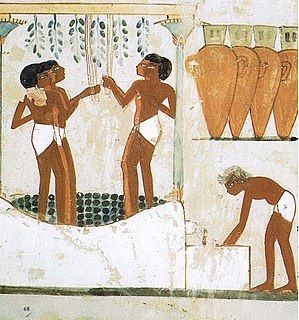Human interactions with microbes
In the Middle Ages, Giovanni Boccaccio's The Decameron and Geoffrey Chaucer's The Canterbury Tales: addressed people's fear of deadly contagion and the moral decline that could result.
Novelists have exploited the apocalyptic possibilities of pandemics from Mary Shelley's 1826 The Last Man and Jack London's 1912 The Scarlet Plague onwards.
Cultural universals in all human societies include expressive forms like art, music, dance, ritual, religion, and technologies like tool usage, cooking, shelter, and clothing.
Only with the invention of the microscope, as used by Robert Hooke in his 1665 book Micrographia,[2] and by Antonie van Leeuwenhoek in the 1670s,[3] the germ theory of disease, and progress in microbiology in the 19th century were microbes observed directly, identified as living organisms, and put to use on a scientific basis.
For example, Streptokinase produced by the bacterium Streptococcus and modified by genetic engineering is used to remove clots from the blood vessels of patients who have suffered a heart attack.
[citation needed] In 1346, the bodies of Mongol warriors of the Golden Horde who had died of plague were thrown over the walls of the besieged Crimean city of Kaffa, possibly assisting the spread of the Black Death into Europe.
[29] The USA similarly explored biological warfare agents,[30] developing anthrax spores, brucellosis, and botulism toxins for possible military use.
[38] The literary possibilities of post-apocalyptic stories about pandemics (worldwide outbreaks of disease) have been explored in novels and films from Mary Shelley's 1826 The Last Man and Jack London's 1912 The Scarlet Plague onwards.
Medieval writings that deal with plague include Giovanni Boccaccio's The Decameron and Geoffrey Chaucer's The Canterbury Tales: both treat the people's fear of contagion and the resulting moral decline, as well as bodily death.
[39] The making of beer has been celebrated in verse since the time of Ancient Sumeria, c. 1800 BC, when the "Hymn to Ninkasi" was inscribed on a clay tablet.
Ninkasi, tutelary goddess of beer, and daughter of the creator Enki and the "queen of the sacred lake" Ninki, "handles the dough and with a big shovel, mixing in a pit, the bappir with [date] honey, ... waters the malt set on the ground, ... soaks the malt in a jar, ... spreads the cooked mash on large reed mats, coolness overcomes, ... holds with both hands the great sweet wort, brewing it with honey".
[40] Wine is a frequent topic in English literature, from the spiced French and Italian "ypocras", "claree", and "vernage" in Chaucer's The Merchant's Tale onwards.
William Shakespeare's Falstaff drank Spanish "sherris sack", in contrast to Sir Toby Belch's preference for "canary".
[42] Microbes and Man is an admired "classic"[43] book, first published in 1969, by the "father figure of British microbiology"[44][45] John Postgate on the whole subject of microorganisms and their relationships with humans.
[47][48] Hollywood was quick to exploit the possibilities of deadly disease, mass infection and drastic government reaction, starting as early as 1922 with Nosferatu, in which a Dracula-like figure, Count Orlok, sleeps in unhallowed ground contaminated with the Black Death, which he brings with him wherever he goes.
Another classic film, Ingmar Bergman's 1957 The Seventh Seal, deals with the plague theme very differently, with the grim reaper directly represented by an actor in a hood.
According to the Tate Gallery, the work "is a roughly modelled organic form, its bulges and single opening suggesting a moving, living creature in the stages of evolution.






